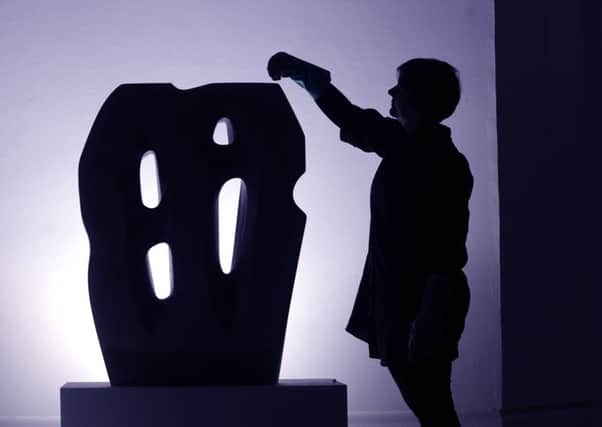How Yorkshire leads the way when it comes to sculpture


Between them Leeds Art Gallery and the Henry Moore Institute have one of the most extensive and impressive collections of British sculpture in the world. Next door neighbours on the Headrow, the twin organisations are now showcasing their works in a ground-breaking exhibition to celebrate their long-standing partnership.
The Sculpture Collections, which runs until September, features around 200 exhibits and spans 14 gallery spaces across both venues. It includes work from the 18th century right through to the present day and tells a fascinating story of sculpture.
Advertisement
Hide AdAdvertisement
Hide Ad“There are around a thousand pieces in the collection, that’s about the same as the Arts Council Collection, which is a national one, so we wanted to showcase that in the exhibition,” says Dr Jon Wood, head of research at the Henry Moore Institute and one of the show’s curators. “We also wanted to celebrate the Institute’s 25th anniversary this year and our long-established and ongoing partnership with Leeds Art Gallery. We are collaborating all the time, but one of the key things we have been working on together is developing the sculpture collections, which cover the 18th, 19th and 20th centuries, plus archive material and works on paper.”
So where do you start with planning and curating an exhibition of this size, selecting from such a huge collection?
“The kind of conversations we were having were around what stories we wanted to tell,” says Wood. “Very early on we knew we wanted to show new or recent acquisitions, large-scale and small-scale work, to give people a really strong sculpture exhibition. All the spaces we are using are really different, so we had to take into consideration the characteristics of each room. We wanted to give people something really memorable and thought-provoking.”
Through their discussions, five perspectives on sculpture began to emerge and the exhibition started to take shape. There are sections devoted to a specific period between 1945 and 1965; the exploration of the recurring motif of the ‘double’ or couplet in sculptural forms; the materiality of stone; single pieces and new acquisitions; and sculpture in relation to drawing and photography.
Advertisement
Hide AdAdvertisement
Hide AdIt makes for a very rich exhibition and one which merits revisiting. So much thought has clearly been put into each section and there are some lovely little instances of neat placement and couplings. Ivon Hitchens’ 1929 painting Henry Moore at Work in his Parkhill Studio, for example, depicting the sculptor working on Reclining Figure, is placed next to the sculpture itself.
A major highlight and a centrepiece to the exhibition is Leeds Art Gallery’s latest acquisition – the magnificent large-scale immersive installation Falling and Walking 2017 by Anne Hardy, a former visiting research fellow at the Henry Moore Institute – which takes up the whole of one of the gallery rooms.
The viewer enters into the space to experience the work – shoes must be removed and photography is not allowed, to ensure a sense of being completely in the moment. There is birdsong and other indistinct, soothing sounds; you could be in a park or on a beach, except everything is bright pink and rows of celluloid film strips hang from the ceiling.
“It is an incredibly ambitious work to have in the collection and we are delighted to have it here,” says Sarah Brown, chief keeper and curator at Leeds Art Gallery. “It is really about how artists are working now and it’s an acquisition that demonstrates how important it is to us that the collection grows, stays contemporary and alive. Leeds has always been a city that collected works of its time, so it is really important to keep things fresh.”
Advertisement
Hide AdAdvertisement
Hide AdThe whole show has that feeling of freshness. Both Leeds Art Gallery and the Henry Moore Institute are part of the Yorkshire Sculpture Triangle – along with the Yorkshire Sculpture Park and The Hepworth Wakefield – and The Sculpture Collections provides an exciting taster for next year’s inaugural Yorkshire Sculpture International, a triennial exhibition across all four venues.
There is an argument for the doors between the two organisations to always remain open after the exhibition finishes, so that visitors can continue to seamlessly move from one to the other. It makes sense – there is no reason why academic rigour and research should be separate from artistic practice.
Certainly walking around the exhibition, it’s obvious how the Henry Moore Institute’s rich documentary archive adds an extra layer to the experience – with photographs, maquettes and drawings from their collection providing historical context for some of the artworks on display.
A nice instance of this is in the section showcasing sculpture made in the period 1945-1965, which includes a maquette of Karl Marx’s memorial sculpture created by sculptor Laurence Bradshaw in 1956 (73 years after Marx’s death) to stand in Highgate Cemetery in London. Alongside the maquette are photographs of Soviet leader Nikita Khrushchev visiting the grave in the 1950s and students lighting candles near it in the 1960s.
Advertisement
Hide AdAdvertisement
Hide Ad“The partnership between Leeds Art Gallery and the Henry Moore Institute is unique,” says Brown. “On the one hand with the Institute there is this incredible academic rigour and scholarship and on the other the gallery is one of the most visited in the country, so to couple that expertise with that access for the first time is very exciting – and long may it continue.”
The Sculpture Collections, at Leeds Art Gallery and the Henry Moore Institute, free entry, until September 2. Falling and Walking by Anne Hardy and Drawings, Models and Sculptures made and selected by Anne Hardy, until May 20.